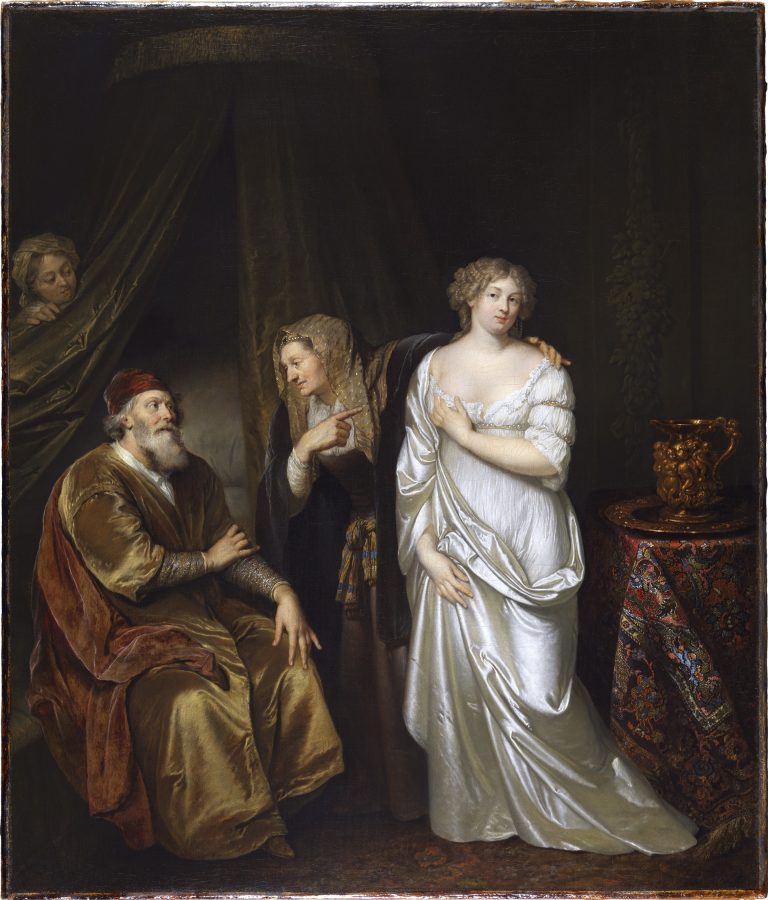After many years of marriage, the biblical patriarch Abraham and his wife, Sarah, were unable to conceive a child.1 In the hope that they might yet beget an heir, Sarah suggested that Abraham try to have a child with her beautiful, young Egyptian maid Hagar. Hagar became pregnant and gave birth to a son, Ishmael, when Abraham was eighty-six years old. When, several years later, Sarah eventually became pregnant and had a son, Isaac, household relations soured. Ishmael began to tease his younger half-brother, leading Sarah to insist that Abraham banish Hagar and Ishmael from the family home; the latter were forced to wander in the desert.
Sarah Leading Hagar to Abraham is one of only two biblical subjects painted by Caspar Netscher (the other is Bathsheba, dated 1667).2 The subject is not only an unusual choice for Netscher, but is generally quite rare in seventeenth-century Dutch art.3 By contrast, other episodes from the Old Testament story of Hagar were fairly common. The Dismissal of Hagar, when Abraham is later forced to expel the Egyptian concubine and his first-born son, was treated on numerous occasions by Pieter Lastman (1583–1633) and his contemporaries, by Rembrandt van Rijn (1606–69), and by artists of the Rembrandt school.4 The appeal of that particular episode lay largely in the complex web of emotions it presented for both artist and audience: Abraham rendered indecisive by conflicting loyalties—faithful to his wife Sarah yet feeling compassion for Hagar and Ishmael; and Hagar, sorrowful, bereft, and fearful of what the future might hold for herself and her young son. In its contrasting of the comforts of the home with the harsh uncertainties of the desert wilderness, the story served a moralizing purpose as well, reinforcing the primacy of the nuclear family and the importance of maintaining domestic order.5
For artists, however, depicting the moment when the aged Sarah introduces her maidservant to her husband with the proposal that he impregnate her in order to fulfill God’s will, offered quite a different set of interpretive possibilities. Rather than exploring wrenching emotions and complex familial relationships, artists appear to have been attracted primarily to the story’s salacious aspects; many used it as an opportunity to depict a partially clad or nude young woman in an acceptable historical context. The sixteenth-century German printmakers Hans Sebald Beham (1500–50) and Georg Pencz (1500–50) made engravings of the subject, which may in turn have influenced Crispijn de Passe the Elder’s engraved illustration for the 1616 edition of the Liber Genesis, a widely circulated book of biblical prints. Not until the late 1630s did the subject appear in paintings: three works by the Caravaggesque painter Matthias Stom (ca. 1600–after 1652) highlight the stark contrast between youth and old age, and, with Sarah cast as the aged procuress, Abraham as the client, and Hagar as the compliant prostitute, present a Biblical take on the perennially popular Dutch genre theme of mercenary love.6
Netscher’s Sarah Leading Hagar to Abraham appears to be the first rendering of the subject in Dutch art for more than two decades, and takes the story in a rather different direction. Like Stom, Netscher’s depiction is influenced by contemporary genre paintings, but rather than looking to bold Caravaggesque scenes of prostitutes, procuresses and their lusty clients, Netscher’s painting fits comfortably in the rarified world of his own elegantly appointed portraits and domestic interiors. Compare, for example, the highly decorative effect of the lush Portrait of Caspar Ingels and Maria Christina Bartolotti van den Heuvel, 1672, or a genteel genre scene such as Musical Company of 1665 (fig 1).7
Traces of the forbidden sensuality and questionable morality that characterize Stom’s dramatic depictions of Sarah, Hagar and Abraham still linger in Netscher’s painting, though they are far more discreetly packaged. Perhaps taking his cue from the Bible, which states that Abraham “was very rich in cattle, in silver, and in gold” (Genesis 13:2), Netscher envelops the figures in luxury: shimmering bed curtains, a massive gold ewer and shallow basin, plush carpets on the table and floor, and fine silk and velvet garments for the figures themselves. Sarah is no longer a haggard crone with clear links to the stereotypical image of the procuress, but a dignified and mature woman, an image more in keeping with her status as the mother of the Jewish nation. Hagar, posed frontally and gazing directly at the viewer, appears oddly disconnected from the transaction that soon dramatically alters her life. Indeed, her attention seems focused entirely on the viewer.
Hagar’s utter passivity and coy outward gaze are expressly designed to entice the viewer, and her half-hearted attempts to preserve her modesty by covering her breasts and grabbing at her white satin gown to prevent it from sliding completely to the floor in fact only draw attention to the voluptuous body beneath. A servant peers from behind the canopied bed curtains at right, her eager spying echoing our own voyeuristic anticipation. The emphasis of Netscher’s painting is on lush visual delights and titillating sensuality; emotions are politely held in check, and the conversation between Sarah and Abraham seems simple and pragmatic, with little evident concern for future repercussions.
The exceptional state of preservation of Sarah Leading Hagar to Abraham allows us to fully appreciate Netscher’s delicate touch and skillful application of paint. His ability to distinguish the varied tactile surfaces within this richly appointed interior enhances the work’s overall sensuality. Although it is not known for whom Netscher painted Sarah Leading Hagar to Abraham, this work was later acquired by Philippe II, duc d’Orléans (1674–1723), Palais Royal, Paris, and stayed in that family’s collection until the late eighteenth century.
